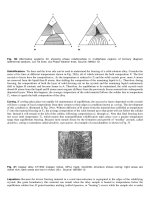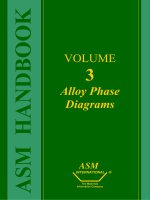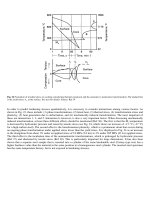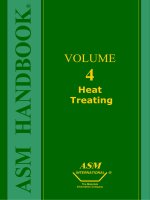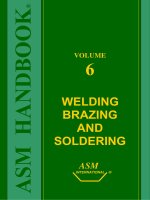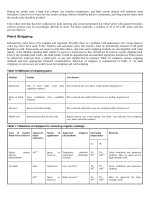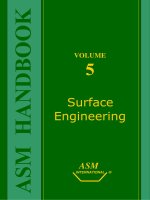ASM Metals HandBook P7
Bạn đang xem bản rút gọn của tài liệu. Xem và tải ngay bản đầy đủ của tài liệu tại đây (975.81 KB, 40 trang )
INTERNATIONAL ®
The Materials
Information Company
Publication Information and Contributors
Heat Treating was published in 1991 as Volume 4 of the ASM Handbook. The Volume was prepared under the direction
of the ASM Handbook Committee.
Authors
• Tohru Arai Toyota Central Research and Development Laboratories, Inc.
• Gordon M. Baker New Age Industries, Inc.
• Charles E. Bates Southern Research Institute
• Bruce A. Becherer Teledyne Vasco Corporation
• Tom Bell University of Birmingham
• Eugene L. Bird Martin Marietta Energy Systems, Inc.
• Bruce L. Bramfitt Bethlehem Steel Corporation
• Robert L. Brennan E.F. Houghton & Company
• Charlie R. Brooks University of Tennessee
• Terrence D. Brown Lindberg Heat Treating Company
• Domenic A. Canonico ABB Combustion Engineering Services
• Earl A. Carlson Lindberg Heat Treating Company
• Arthur Cohen Copper Development Association, Inc.
• James M. Dahl Carpenter Technology Corporation
• Daniel A. DeAntonio Carpenter Technology Corporation
• A.J. DeArdo University of Pittsburgh
• Douglas V. Doane Consulting Metallurgist
• Jon L. Dossett Midland Metal Treating, Inc.
• Joseph Douthett Armco Research and Technology
• David Duhl Pratt & Whitney, a Division of United Technologies Corporation
• Torsten Ericsson Linköping Institute of Technology
• Howard A. Ferguson Metallurgical Consultant
• James H. Filkowski Litton Precision Gear
• Robert W. Foreman Consultant
• B. Furchheim Sächsische Elektronenstrahl GmbH
• C.I. Garcia University of Pittsburgh
• M. Gergely Steel Advisory Center for Industrial Technologies, Hungary
• Roger Gilbert IMI Titanium
• Arthur D. Godding Heatbath Corporation
• Dan Goodman Surface Combustion, Inc.
• William L. Grube General Motors Research Laboratories
• Richard B. Gundlach Climax Research Services
• William B. Hampshire Tin Information Center
• Steven Harper Arvin Industries
• Peter A. Hassell Hassell Associates
• J.R. Hensley Inco Alloys International, Inc.
• Anil K. Hingwe Molloy Manufacturing Company
• Mandar K. Hingwe Atmosphere Annealing, Inc.
• Timothy Howson Wyman Gordon Company
• Lyle R. Jenkins Ductile Iron Society
• Paul Johnson National-Standard Company
• John R. Keough Atmosphere Group, Inc.
• John S. Kirkaldy McMaster University
• Christopher M. Klaren John Deere, Waterloo Works
• Conrad H. Knerr Metlab
• T. Konkoly Technical University Budapest
• Bela Kovacs Atmosphere Group, Inc.
• George Krauss Colorado School of Mines
• George Y. Lai Haynes International, Inc.
• W. James Laird, Jr. The Metal Works Industrial Furnaces, Inc.
• Steve Lampman ASM International
• Gerard M. Ludtka Martin Marietta Energy Systems, Inc.
• James M. Manning Inco Alloys International, Inc.
• Daniel W. McCurdy Marathon Monitors, Inc.
• James Nelson Buehler Ltd.
• James M. O'Brien O'Brien & Associates
• Raymond Ostrowski Protection Controls, Inc.
• E.J. Palmiere University of Pittsburgh
• S. Panzer Forschungsgesellshaft für Elektronenstrahl-und Plasmatechnik mbH
• Roger Pradhan Bethlehem Steel Corporation
• T. Réti Bánki Donát Polytechnic, Hungary
• Al Robertson Englehard Corporation
• Kurt Rohrbach Carpenter Technology Corporation
• Thomas C. Rose Alloy Hard Surfacing, Inc.
• Nicholas V. Ross Ajax Magnethermic Corporation
• Michael F. Rothman Haynes International, Inc.
• John G. Rowe Union Carbide Industrial Gases Inc., Linde Division
• Thomas Ruglic Hinderliter Heat Treating, Inc.
• Karl B. Rundman Michigan Technological University
• Larry Ryan Lindberg Heat Treating Company
• Robert F. Sagon-King Can-Eng Ltd.
• Jeremy St. Pierre C.I. Hayes, Inc.
• Ole A. Sandven Trumpf Industrial Lasers, Inc.
• S. Schiller Forschungsgesellshaft für Elektronenstrahl-und Plasmatechnik mbH
• Michael Schmidt Carpenter Technology Corporation
• C. Richard Shannon Teledyne Allvac
• John A. Shields, Jr. Climax Specialty Metals
• Anil Kumar Sinha Bohn Piston Division
• Gaylord Smith Inco Alloys International, Inc.
• John W. Smith Holcroft
• S. Somogyi Steel Advisory Center for Industrial Technologies, Hungary
• Archie Stevenson Magnesium Elektron, Inc.
• C.A. Stickels Ford Motor Company
• Albert S. Tenney III Leeds & Northrup, Unit of General Signal Corp.
• Donald J. Tillack Inco Alloys International, Inc.
• George E. Totten Union Carbide Chemicals and Plastics Company Inc.
• Steven Verhoff Surface Combustion, Inc.
• Charles F. Walton Consultant
• Herbert Webster Phoenix Heat Treating, Inc.
• Michael W. Wisti Atmosphere Annealing, Inc.
• Thomas J. Witheford Teledyne Vasco Corporation
Reviewers and Contributors
• Hubert I. Aaronson Carnegie Mellon University
• Marcus W. Abney Fairfield Manufacturing Company, Inc.
• Al Alagarsamy Grede Foundries, Inc.
• B.L. Averbach Massachusetts Institute of Technology
• Robert Bakish Bakish Materials Corporation
• Randall F. Barron Louisiana Tech University
• Fred J. Bartkowski Marshall W. Nelson & Associates, Inc.
• Charles E. Bates Southern Research Institute
• Edward C. Bayer Holcroft-TPS
• Bruce A. Becherer Teledyne Vasco
• David A. Belforte Belforte Associates
• W.J. Bernard, Jr. Surface Combustion, Inc.
• Dennis Bernier Kester Solder
• Peter Bielik Eppert Oil Company
• Earnest Bishop Park Chemical Company
• Richard J. Blewett Hard Core Heat Treating Inc.
• John R. Blutt Laser Industries Inc.
• Alan H. Braun Fansteel-Wellman Dynamics
• Jack W. Bray Reynolds Metals Company
• Jim Brookes Braun Engineering
• Terrence D. Brown Lindberg Heat Treating Company
• H. Burrier The Timken Company
• J.F. Butler LTV Steel Technology Center
• Dean Caerner PPG
• Joseph M. Capus Technical Consultant
• Robert G. Carlson G.E. Aircraft Engines
• Roger Carlson Lindberg Corporation
• Jan L. Caruso Republic Engineered Steels, Inc.
• Barrie Cayless Alcan Rolled Products Company
• Gerald Chantres Commonwealth Industries
• Roy Chestner Barber Coleman Company
• Bob Christ Deere & Company Technical Center
• Douglas H. Clingner Fairfield Manufacturing Company, Inc.
• James G. Conybear ABAR Ipsen Industries
• Michael Crews Burns Cold Forge
• T. Cullen Potomic Electric Power
• William J. Davison Baltimore Specialty Steels Corporation
• R. Decker University Science Partners, Inc.
• Laurence S. Delose Texcel, Inc.
• Sanjeev S. Deshpande Atmosphere Annealing Inc.
• Bill Detrick Funk Manufacturing Company
• George Dimou Englehard Canada Limited
• R. Dirscherl Nooter Corporation
• D. Doane Technical Consultant
• John Dodd Dodd & Associates
• David Donegan Rockwell International
• J. Dossett Midland Metal Treating, Inc.
• David Duarte Lindberg Heat Treat Company
• James R. Easterday Kolene Corporation
• Mahmoud Eboo Aluminum Laser Corporation
• Peter Elliott Corrosion and Materials Consultancy
• Dana Elza Coherent General
• Loren Epler Dynamic Metal Treating Inc.
• Roger J. Fabian Lindberg Heat Treating Company
• Robert W. Foreman Technical Consultant
• Gregory A. Fuller The Timken Company
• Dean J. Gaertner PPG Industries
• Amal Ganguli Cleveland Pneumatic Company
• Edward C. Gayer Technical Consultant
• Dave Gaylord Progressive Heat Treat
• Dennis J. Giancola H.P. Technologies, Inc.
• Doug Glenn Seco/Warwick Corporation
• Arthur D. Godding Heatbath Corporation
• Michael Gratti Barber Coleman Company
• Indra Gupta Inland Steel Research Laboratories
• Neil Hacker Ipsen Commercial Heat Treating
• Lawrence J. Hagerty Union Carbide Industrial Gases Inc.
• Richard E. Haimbaugh Induction Heat Treating Corporation
• Steven S. Hansen Bethlehem Steel Corporation
• Jack Hasson E.F. Houghton & Company
• Richard L. Heestand Oak Ridge National Laboratory
• J.R. Hensley Inco Alloys International Inc.
• W.E. Heyer Technical Consultant
• Anil Hingwe Molloy Manufacturing
• Robert S. Hodder Latrobe Steel Company, Subsidiary of The Timken Company
• Gerald G. Hoeft Caterpillar Inc.
• J.M. Hoegfedt Honeywell Inc.
• Curtis Holmes Commonwealth Industries
• John D. Hubbard Hinderliter Heat Treating
• Jack Hughes Detroit Flame Hardening
• Christ J. Iatropulos Kieh Company
• Michael T. Ives Park Chemical Company
• Edward Jamieson Lindberg Heat Treating
• Larry Jarvis Tenaxol Inc.
• Joseph Jasper Armco, Inc.
• Raoul L. Jeanmenne Caterpillar Inc., Construction and Mining Products Division
• Lyle R. Jenkins Ductile Iron Society
• Paul E. Johnson National-Standard
• Michael C. Kasprzyk Inex Inc.
• Norman O. Kater Ladish Company
• Norman O. Kates Lindberg Corporation
• John Kay CAN-ENG
• Leon E. Keene Metal Treating Inc.
• Roger H. Keeran Metal-Labs, Inc.
• Gary Keil Caterpillar Inc.
• James Kelley Rolled Alloys
• John M. Kelso Benedict-Miller Inc.
• W. Keough Atmosphere Furnace Company
• Hugh S. Kim Mack Trucks, Inc.
• Bela Kovacs Atmosphere Furnace Company
• George Krauss Colorado School of Mines
• Kenneth M. Krewson J.W. Rex Company
• Dale LaCount Babcock & Wilcox Company
• W. James Laird, Jr. Metal Works Industrial Furnaces
• Ron Larson Chicago Magnesium Casting Corporation
• Jack Laub Advanced Cast Products, Inc.
• Graham Legge ABAR-IPSEN
• Jeffrey Levine Applied Cryogenics, Inc.
• Norman P. Lillybeck Deere & Company Technical Center
• Gerald T. Looby Republic Engineered Steel, Inc.
• John Lueders John Deere Waterloo Works
• Robert Luetje Kolene Corporation
• Colin Mackay Microelectronic Computer Technology Corporation
• Thomas Mackey Texas Copper Corporation
• David Malley Pratt & Whitney Company
• James M. Manning Inco Alloys International, Inc.
• Eric B. Manos Buehler International
• David K. Matlock Colorado School of Mines
• Gernant E. Maurer Special Metals Corporation
• Terry Mayo Reed Tool Company
• Dale E. McCoy Lite Metals Company
• Jocelyne O. McGeever Liquid Air Corporation
• Katie Megerle Naval Air Engineering Center
• Quentin D. Mehrkam Ajax Electric Company
• Pares Mehta Eaton, Truck Components Headquarters
• Anthony G. Meszaros Whittaker Park Chemical Company
• J. Meyer SKF Industries
• Glen Moore Burges-Norton Company
• Peter J. Moroz Armco, Inc.
• Raymond Mosser Republic Engineered Steels, Inc.
• Patrick J. Murzyn Union Carbide Industrial Gases, Inc.
• Frank B. Nair GTE Products Corporation
• Dan Neiber IPSEN Commercial Heat Treating
• Robert L. Niemi Ladish Company, Inc.
• Bob Noel Ladish Company, Inc.
• James O'Brien O'Brien and Associates
• John T. O'Reilly The Doe Run Company
• Wayne F. Parker W.F. Parker & Associates
• James L. Parks ME International
• Burton R. Payne, Jr. Payne Chemical Corporation
• Leander F. Pease III Powder-Tech Associates, Inc.
• Ralph Poor Surface Combustion Inc.
• David Prengamen RSR Corporation
• Walter Prest Aeco-Warwick Corporation
• Peter E. Price Industrial Materials Technology, Inc.
• Tom Prucha Technical Consultant
• Beu Rassieur Paulo Products Company
• Brian Reed Park Thermal
• William T. Reynolds, Jr. Virginia Polytechnic Institute and State University
• Ron Rhoads Dana Corporation
• Rick Riccardi North American Manufacturing
• Jack Rorick Lindberg Heat Treating Company
• Thomas Ruglic Hinderliter Heat Treating, Inc.
• Karl B. Rundman Michigan Technology University
• Larry B. Ryan Lindberg Heat Treating Company
• Joseph J. Rysek Lubrizol Corporation
• Robert F. Sagon-King CAN-ENG
• R. Sawtell Alcoa International
• David Scarrott Scarrott Metallurgical
• Charles J. Scholl Wyman Gordon Company
• Danny E. Scott Hughes Tool Company
• Eugene D. Seaton Alcoa Forging Division
• Gerald Seim Sacoma International, Inc.
• Soren Segerberg The Swedish Institute of Production Engineering Research, IVF
• Richard H. Shapiro Arrow Gear Company
• Gary L. Sharp Advanced Heat Treat Corporation
• Michael M. Shea General Motors Research Laboratories
• Charles Shield Ford Motor Company
• Stephen J. Sikirica Gas Research Institute
• Paul J. Sikorsky The Trane Company
• Thomas Simons Dana Corporation
• Darrell F. Smith, Jr. Inco Alloys International, Inc.
• W. Smith University of Florida
• Richard A. Sommer Ajax Magnethermic Corporation (Retired)
• G. Sorell G. Sorell Consulting Services
• Peter D. Southwick Inland Steel Flat Products Company
• Talivaldis Spalvins NASA-Lewis Research Center
• Warren M. Spear Nickel Development Institute
• Keith Stewart Lindberg Heat Treating Company
• Charles A. Stickels Ford Motor Company
• Peter R. Strutt University of Connecticut
• James M. Sullivan Honeywell Inc., Industrial Heat Equipment Markets
• Joseph W. Tackett Haynes International Inc.
• Imao Tamura The Research Institute for Applied Sciences
• M.H. Thomas LTV Steels Corporation
• Steven Thompson Colorado School of Mines
• Donald J. Tillack Inco Alloys International Inc.
• George A. Timmons Retired
• George Totten Union Carbide Chemicals & Plastics Company, Inc.
• Julius Turk Paulo Products Company
• Kris Vaithinathan Engelhard Corporation
• Steve H. Verhoff Surface Combustion Inc.
• Peter Vernia General Motors Research Laboratories
• Dennis T. Vukovich Eaton Corporation
• Dennis M. Wagen W-B Combustion, Inc.
• G. Walter J.I. Case
• W. Weins University of Nebraska
• William L. Wentland Sundstrand Aerospace
• Charles V. White GMI, Engineering Management Institute
• Glenn K. White E.I. Du Pont de Nemours & Company, Inc.
• Don Whittaker Electric Furnace Company
• Thomas J. Withefordd Teledyne Vasco
• John R. Whyte, Jr. Procedyne Corporation
• Timothy I. Wilde Anarad, Inc.
• Richard K. Wilson Inco Alloys International
• Gary J. Wiskow Falk Corporation
• Michael W. Wisti Atmosphere Annealing, Inc.
• Curtiss J. Wolf AGA Gas, Inc.
• Thomas Wood Cytemp
• Anthony W. Worcester The Doe Run Company
• Philip L. Young, Jr. Union Carbide Industrial Gases, Inc.
• John R. Young Alpha Steel Treating Company
Foreword
Heat-treating technology has long been an area of deep interest and concern to ASM members. In fact, the origin of the
Society can be traced back to 1913 when the Steel Treaters Club was launched in Detroit. This group joined with the
American Steel Treaters Society to form the American Society for Steel Treating in 1920. It was the latter organization
that issued the first bound Handbook in 1928, a volume that would serve as the prototype for future generations of the
ASM Handbook.
During the ensuing six decades, many changes have taken place--both in terms of the positioning of the Society and the
technology base it serves. In 1933 a name change to the American Society for Metals completed the transition from an
organization concerned primarily with heat treating to one that served the interests of the entire metals industry. Finally in
1987, the technical scope of the Society was further broadened to include the processing, properties, and applications of
all engineering/structural materials, and thus ASM International was born.
Despite these momentous changes, one fact has remained unchanged--ASM's recognition of heat treating as one of the
foundations of the metals sciences and its unflagging commitment to this ever-changing technology. The publication of
Volume 4 of the ASM Handbook is the most recent and significant example of the sustained leadership of the Society in
addressing the needs of the heat treat community.
The present volume reflects the continuing research and effort that have led to a deeper understanding of the response of
ferrous and nonferrous alloys to thermal treatments. For in the 10 years since publication of its 9th Edition predecessor,
significant developments have taken place in quenching and hardenability studies, computer modelling of heat-treating
operations, plasma-assisted case hardening methods, and improved quality control through advanced instrumentation
and/or the application of statistical process control. These are but a few of the important topics that will undoubtedly
contribute toward making the Heat Treating Handbook a timeless contribution to the literature.
Successful completion of such a formidable project, however, is dependent on the collective effort of a vast pool of
knowledgeable and dedicated professionals. For their significant roles in this project, we are truly indebted to the ASM
Heat Treating Technical Division and its subcommittees, to the Handbook Committee, to the hundreds of individual
authors and reviewers, and the Handbook Editorial Staff. For their valuable contributions, we extend our thanks and
gratitude.
• Stephen M. Copley
President
ASM International
• Edward L. Langer
Managing Director
ASM International
Preface
In compiling this new volume on heat treating, the challenge was to produce a book that contained subject matter strongly
oriented toward industrial practice but that did not omit discussions of the underlying metallurgical fundamentals. With
previously published ASM Handbooks devoted to heat treating, the omission of material on fundamentals was justified by
either space limitations and/or the availability of other ASM books that described the physical metallurgy associated with
thermal treatments. For example, when the 8th Edition was published in 1964, only 306 pages were related to heat
treating (this Volume was divided between heat-treating technology and surface cleaning and finishing). As such, readers
were referred to the classic book Principles of Heat Treatment by M.A. Grossmann and E.C. Bain, which was also
published in 1964 by ASM. A similar situation arose in 1981 when the expanded 9th Edition Heat Treating Handbook
was published. In the year prior to this publication, a completely revised version of the Grossmann/Bain book was
prepared by G. Krauss and subsequently published by ASM.
The 1980s proved to be a dynamic period for heat-treating technology--a decade that witnessed the introduction of new
alloys and processes as well as new "tools" for understanding the response of heat-treated materials. For example, new
alloys under active development or brought to market during the 1980s that were not described in previous heat-treating
Handbooks included duplex stainless steels, microalloyed (HSLA) steels, low-cobalt maraging steels, austempered ductile
iron, directionally solidified and single-crystal superalloys, and aluminum-lithium alloys.
Changes in processing include improvements in continuous annealing, induction heating, and surface hardening
operations using lasers or electron beams, the commercial viability of plasma-assisted case-hardening processes, and
advances in thermomechanical processing.
But by far the most dramatic changes in heat-treat technology that have marked the past decade have been those involving
newly developed tools for improving process characterization and process control. These include improved
instrumentation for controlling furnace temperature, furnace atmosphere, and surface carbon content, the practical
application of statistical process control (SPC), and the use of computer modelling for both the prediction of hardness
profiles after quenching and the quantitative modelling of properties after tempering or case hardening. It is this latter
category of computer modelling that necessitates the inclusion of material on the basic principles or fundamentals of heat
treating. For example, there are several articles in this Volume that deal with computer-assisted prediction of steel
hardening and hardenability as a function of heat treatment parameters. In this regard, the primary measures of steel
hardening are the end-quench hardenability curves (Jominy curves), isothermal transformation (IT) curves, and
continuous cooling transformation (CCT) curves. In order to understand how computer programs can be used to calculate
such diagrams, some brief background information is provided in several key articles to emphasize how these diagrams
make possible the selection of steel and the design of proper heat treatments.
Principal Sections
Volume 4 has been organized into eight major sections:
• Heat Treating of Steel
• Surface Hardening of Steel
• Heat-Treating Equipment
• Process and Quality Control Considerations
• Heat Treating of Cast Irons
• Heat Treating of Tool Steels
• Heat Treating of Stainless Steels and Heat-Resistant Alloys
• Heat Treating of Nonferrous Alloys
A total of 71 articles are contained in these sections. Of these, 16 are new, 17 were completely rewritten, with the
remaining articles revised and/or expanded. In addition, several important appendices supplement the Volume. These
include a glossary of terms, a temper color chart for steels, and tabulated austenitizing temperatures for steels. A review
of the content of the major sections is given below; highlighted are differences between the present volume and its 9th
Edition predecessor. Table 1 summarizes the content of the principal sections.
Table 1 Summary of contents of Volume 4, Heat Treating, of the ASM Handbook
Section title Number of articles Pages Figures
(a)
Tables
(b)
References
Heat Treating of Steel 16 253 355 123 430
Surface Hardening of Steel 18 203 305 69 324
Heat-Treating Equipment 6 62 83 17 43
Process and Quality Control Considerations 9 135 130 43 190
Heat Treating of Cast Irons 5 42 67 19 27
Heat Treating of Tool Steels 4 56 48 34 20
Heat Treating of Stainless Steels and Heat-Resistant Alloys 3 51 41 53 23
Heat Treating of Nonferrous Alloys 10 124 147 77 72
Total 71 926 1176 435 1129
(a)
Total number of figure captions; most figures include more than one illustration.
(b)
Does not include in-text tables or tables that are part of figures
Heat Treating of Steel. This section begins with two entirely new articles that introduce the reader to the physical
metallurgy of heat-treated steels and newly developed methodologies for quantitatively predicting transformation
hardening in steels. These companion papers set the stage for a series of articles that describe specific types of heat
treatments. Of particular note is the definitive treatise on "Quenching of Steel" by Bates, Totten, and Brennan. Featuring
some 95 figures and 23 tables, this 55 page article has been substantially revised and expanded from previous Editions.
Other highlights include new articles on continuous annealing, cryogenic treatment of steel, and thermomechanical
processing of microalloyed steel. The section concludes with completely rewritten articles on heat-treat procedures for
ultrahigh strength steels, maraging steels, and powder metallurgy ferrous alloys.
Surface Hardening of Steel. As explained in the introductory article to this section, emphasis has been placed on
thermally driven, diffusion processes that induce solid-state transformation hardening. These processes include flame
hardening, high-energy processes that utilize laser beams or electron beams, and conventional surface treatments such as
carburizing, nitriding, and carbonitriding.
It is important to note the significant processing characteristics between the aforementioned processes and surface
modification techniques 'such as ion implantation, PVD/CVD coatings, and surface melting/surface alloying processes
that will be described in future volumes of this Handbook series. For example ion nitriding, which is described in this
section, and nitrogen ion implantation are two distinctly different techniques for producing a case hardened surface layer.
The implementation of each process, the characteristics of the case layers produced, the metallurgical strengthening
mechanisms generated, and the economics and end use of each, are quite different.
Ion nitriding is a thermally driven, equilibrium, diffusion process that produces a relatively deep (100 to 400 m),
hardened, case layer. Nitrogen ion implantation is a non-thermal, non-equilibrium, physically driven, ballistic alloying
process, which produces a relatively shallow (1 μm), extremely hard case layer. Ion nitriding is implemented at high
temperatures in a glow discharge atmosphere, while nitrogen ion implantation is carried out at room temperature, at high
vacuum, in a dedicated atomic particle accelerator. Case layer strengthening in ion nitrided surfaces is due primarily to
formation of transition metal nitride precipitates, while strengthening in nitrogen ion implanted surfaces is due primarily
to dislocation pinning. A summary of processing comparisons is given in Table 2.
Table 2 Process characteristics comparison
Process
temperature
Process Type Process
time,
h
°C °F
Process
pressure,
torr
Case
depth
(a)
,
μm
Hardness
(a)
,
HRC
Ion nitriding Thermal
diffusion
10-30 500-
1100
900-
2000
0.2-5.0 400 62-67
Nitrogen ion Physical 1-6 <150 <300 10
-6
1 80-90
(a)
Value for steel
Key additions to this section include articles that describe increasingly used processes such as plasma-assisted case
hardening methods, boriding, and the Toyota diffusion process. Of critical importance to this section is the article
"Microstructures and Properties of Carburized Steels" by G. Krauss which examines the correlation between processing,
structure, and resulting fatigue, fracture, and wear properties of case-hardened steels.
Heat-Treating Equipment. Types of heat-treating furnaces, the materials used to construct furnaces, and the
advantages and limitations associated with each are described next. More emphasis has been placed on furnace energy
efficiency and proper design than in previous Editions.
Process and quality control considerations are more important than ever to heat treaters. Reliable sensors,
computerized control equipment, and process control of heating and cooling and furnace atmospheres are described in
detail in this section. Supplementing this material are new articles on the recognition and prevention of defects in heat-
treated parts and the use of computer programs for designing heat-treat operations and predicting the properties of heat-
treated steels.
Because the heat-treating industry is being challenged to introduce statistical concepts in order to minimize variability and
ensure consistent quality of heat-treated parts, an important article on "Statistical Process Control of Heat-Treating
Operations" is also included. Emphasis is on the practical application of SPC concepts in order to demonstrate to heat
treaters how to identify critical process parameters that influence product quality and how to establish methods to monitor
and evaluate such parameters.
Heat treating of cast irons is described in five articles. The "Introduction to Heat Treating of Cast Irons" was
completely rewritten for this Volume. The remaining four articles contain new information on austempering of ductile
iron and procedures for heat treating highly alloyed abrasion-resistant, corrosion-resistant, and heat-resistant cast irons.
Heat Treating of Tool Steels. Because tool steels must be processed to develop specific combinations of wear
resistance, resistance to deformation or fracture under high loads, and resistance to softening under elevated temperatures,
proper heat treating is critical. This section describes the procedures and equipment necessary to meet these criteria.
Heat Treating of Stainless Steels and Heat-Resistant Alloys. Procedures and process control for heat treating
the principal types of stainless steels and superalloys are discussed in this section. The article on "Heat Treating of
Superalloys" was completely rewritten for this Volume and includes information on both wrought and cast alloys, many
of which are used in the aerospace industry. The article on refractory metals and alloys is completely new to the
Handbook series.
Heat Treating of Nonferrous Alloys. The principles which govern heat treatment of nonferrous alloys are first
described in this final section of the Handbook. Differences between ferrous and nonferrous processing are highlighted.
Nine articles follow on heat treating of specific classes of nonferrous alloys.
Acknowledgments
This Handbook would not have been possible without the generous contributions of the nearly 350 leading heat-treating
experts who donated their expertise as authors and reviewers. They represent many of the leading industries and
educational institutions in this country and abroad. The articles in this Handbook represent tremendous individual as well
as committee efforts. We are also grateful to the ASM Heat Treating Technical Division and the ASM Handbook
Committee. Their guidance during the critical planning stages of this project proved invaluable. This has truly been a
collective effort of the technical community. We thank those who willingly have shared their knowledge with us.
The Editors
General Information
Officers and Trustees of ASM International
Officers
• Stephen M. Copley President and Trustee Illinois Institute of Technology
• William P. Koster Vice President and Trustee Metcut Research Associates Inc.
• Klaus M. Zwilsky Immediate Past President and Trustee National Materials Advisory Board
National Academy of Sciences
• Edward L. Langer Secretary and Managing Director ASM International
• Robert D. Halverstadt Treasurer AIMe Associates
Trustees
• John V. Andrews Teledyne, Inc.
• Edward R. Burrell Inco Alloys International, Inc.
• William H. Erickson Canada Centre for Minerals & Energy Technology
• Norman A. Gjostein Ford Motor Company
• Nicholas C. Jessen, Jr. Martin Marietta Energy Systems, Inc.
• Kenneth F. Packer Packer Engineering, Inc.
• Hans Portisch VDM Technologies Corporation
• John G. Simon General Motors Corporation
• Charles Yaker Howmet Corporation
Members of the ASM Handbook Committee (1991-1992)
• David LeRoy Olson (Chairman 1990-; Member 1982-1988; 1989-) Colorado School of Mines
• Ted Anderson (1991-) Texas A&M University
• Roger J. Austin (1984-) Hydro-Lift
• Robert J. Barnhurst (1988-) Noranda Technology Centre
• John F. Breedis (1989-) Olin Corporation
• Stephen J. Burden (1989-) GTE Valenite
• Craig V. Darragh (1989-) The Timken Company
• Russell J. Diefendorf (1990-) Clemson University
• Aicha Elshabini-Riad (1990-) Virginia Polytechnic & State University
• F. Reed Estabrook Jr. (1990-) Consultant
• Michelle M. Gauthier (1990-) Raytheon Company
• Toni Grobstein (1990-) NASA Lewis Research Center
• Susan Housh (1990-) Dow Chemical U.S.A.
• Dennis D. Huffman (1982-) The Timken Company
• S. Jim Ibarra (1991-) Amoco Research Center
• J. Ernesto Indacochea (1987-) University of Illinois at Chicago
• John B. Lambert (1988-) Fansteel Inc.
• Peter W. Lee (1990-) The Timken Company
• William L. Mankins (1989-) Inco Alloys International, Inc.
• David V. Neff (1986-) Metaullics Systems
• Richard E. Robertson (1990-) University of Michigan
• Elwin L. Rooy (1989-) Aluminum Company of America
• Jeremy C. St. Pierre (1990-) Hayes Heat Treating Corporation
• Ephraim Suhir (1990-) AT&T Bell Laboratories
• Kenneth Tator (1991-) KTA-Tator, Inc.
• William B. Young (1991-) Dana Corporation
Previous Chairmen of the ASM Handbook Committee
• R.S. Archer (1940-1942) (Member, 1937-1942)
• L.B. Case (1931-1933) (Member, 1927-1933)
• T.D. Cooper (1984-1986) (Member, 1981-1986)
• E.O. Dixon (1952-1954) (Member, 1947-1955)
• R.L. Dowdell (1938-1939) (Member, 1935-1939)
• J.P. Gill (1937) (Member, 1934-1937)
• J.D. Graham (1966-1968) (Member, 1961-1970)
• J.F. Harper (1923-1926) (Member, 1923-1926)
• C.H. Herty, Jr. (1934-1936) (Member, 1930-1936)
• D.D. Huffman (1986-1990) (Member, 1990-)
• J.B. Johnson (1948-1951) (Member, 1944-1951)
• L.J. Korb (1983) (Member, 1978-1983)
• R.W.E. Leiter (1962-1963) (Member, 1955-1958,1960-1964)
• G.V. Luerssen (1943-1947) (Member, 1942-1947)
• G.N. Maniar (1979-1980) (Member, 1974-1980)
• J.L. McCall (1982) (Member, 1977-1982)
• W.J. Merten (1927-1930) (Member, 1923-1933)
• N.E. Promisel (1955-1961) (Member, 1954-1963)
• G.J. Shubat (1973-1975) (Member, 1966-1975)
• W.A. Stadtler (1969-1972) (Member, 1962-1972)
• R. Ward (1976-1978) (Member, 1972-1978)
• M.G.H. Wells (1981) (Member, 1976-1981)
• D.J. Wright (1964-1965) (Member, 1959-1967)
Staff
ASM International staff who contributed to the development of the Volume included Robert C. Uhl, Director of
Reference Publications; Joseph R. Davis, Manager of Handbook Development; Grace M. Davidson, Production Project
Manager; Steven R. Lampman, Technical Editor; Theodore B. Zorc, Technical Editor; Janice L. Daquila, Assistant
Editor; Alice W. Ronke, Assistant Editor; Kari L. Henninger, Editorial/Production Assistant. Editorial assistance was
provided by Robert T. Kiepura, Heather F. Lampman, Penelope Thomas, and Nikki D. Wheaton.
Conversion to Electronic Files
ASM Handbook, Volume 4, Heat Treating was converted to electronic files in 1998. The conversion was based on the
Third Printing (1995). No substantive changes were made to the content of the Volume, but some minor corrections and
clarifications were made as needed.
ASM International staff who contributed to the conversion of the Volume included Sally Fahrenholz-Mann, Bonnie
Sanders, Marlene Seuffert, Scott Henry, Robert Braddock, and Kathleen Dragolich. The electronic version was prepared
under the direction of William W. Scott, Jr., Technical Director, and Michael J. DeHaemer, Managing Director.
Copyright Information (for Print Volume)
Copyright © 1991 by ASM International
All Rights Reserved.
ASM Handbook is a collective effort involving thousands of technical specialists. It brings together in one book a wealth
of information from world-wide sources to help scientists, engineers, and technicians solve current and long-range
problems.
Great care is taken in the compilation and production of this Volume, but it should be made clear that no warranties,
express or implied, are given in connection with the accuracy or completeness of this publication, and no responsibility
can be taken for any claims that may arise.
Nothing contained in the ASM Handbook shall be construed as a grant of any right of manufacture, sale, use, or
reproduction, in connection with any method, process, apparatus, product, composition, or system, whether or not covered
by letters patent, copyright, or trademark, and nothing contained in the ASM Handbook shall be construed as a defense
against any alleged infringement of letters patent, copyright, or trademark, or as a defense against liability for such
infringement.
Comments, criticisms, and suggestions are invited, and should be forwarded to ASM International.
Library of Congress Cataloging-in-Publication Data (for Print Volume)
ASM Handbook (Revised vol. 4) Metals Handbook. Title proper has changed with v.4: ASM Handbook/Prepared under
the direction of the ASM International Handbook Committee. Includes bibliographies and indexes. Contents: v. 4. Heat
Treating.
1. Metals-Handbooks, manuals, etc. I. ASM International. Handbook Committee. II. Title: ASM Handbook.
TA459.M43 1990 620.1'6 90-115
ISBN 0-87170-379-3
SAN 204-7586
Printed in the United States of America
Principles of Heat Treating of Steels
Torsten Ericsson, Linköping Institute of Technology, Sweden
Introduction
A STEEL is usually defined as an alloy of iron and carbon with the carbon content between a few hundreds of a percent
up to about 2 wt%. Other alloying elements can amount in total to about 5 wt% in low-alloy steels and higher in more
highly alloyed steels such as tool steels and stainless steels. Steels can exhibit a wide variety of properties depending on
composition as well as the phases and microconstituents present, which in turn depend on the heat treatment. In
subsequent articles in this Section, various types of heat treatment are described in detail. In this article, an outline of the
physical metallurgy associated with heat treating of steels will be given and some important "tools" will be introduced.
Deliberately no microstructures are shown as a well-illustrated article exists in "Microstructures, Processing, and
Properties of Steels," by G. Krauss in Properties and Selection: Irons, Steels, and High-Performance Alloys, Volume 1 of
ASM Handbook. A companion article that emphasizes information systems for predicting microstructures and hardnesses
of quenched steels follows (see the article"Quantitative Prediction of Transformation Hardening in Steels" in this
Volume).
The Fe-C Phase Diagram
The basis for the understanding of the heat treatment of steels is the Fe-C phase diagram (Fig. 1). Because it is well
explained in earlier volumes of ASM Handbook, formerly Metals Handbook (Ref 1, 2, 3), and in many elementary
textbooks, it will be treated very briefly here. Figure 1 actually shows two diagrams; the stable iron-graphite diagram
(dashed lines) and the metastable Fe-Fe
3
C diagram. The stable condition usually takes a very long time to develop,
especially in the low-temperature and low-carbon range, and therefore the metastable diagram is of more interest. The Fe-
C diagram shows which phases are to be expected at equilibrium (or metastable equilibrium) for different combinations of
carbon concentration and temperature. Table 1 provides a summary of important metallurgical phases and
microconstituents. We distinguish at the low-carbon end ferrite (α-iron), which can at most dissolve 0.028 wt% C at 727
°C (1341 °F) and austenite (γ-iron), which can dissolve 2.11 wt% C at 1148 °C (2098 °F). At the carbon-rich side we find
cementite (Fe
3
C). Of less interest, except for highly alloyed steels, is the δ-ferrite existing at the highest temperatures.
Between the single-phase fields are found regions with mixtures of two phases, such as ferrite + cementite, austenite +
cementite, and ferrite + austenite. At the highest temperatures, the liquid phase field can be found and below this are the
two phase fields liquid + austenite, liquid + cementite, and liquid + δ-ferrite. In heat treating of steels, the liquid phase is
always avoided. Some important boundaries at single-phase fields have been given special names that facilitate the
discussion. These include:
• A
1
, the so-called eutectoid temperature, which is the minimum temperature for austenite
• A
3
, the lower-temperature boundary of the austenite region at low carbon contents, that is, the γ/γ + α
boundary
• A
cm
, the counterpart boundary for high carbon contents, that is, the γ/γ + Fe
3
C boundary
Sometimes the letters c, e, or r are included. Relevant definitions of terms associated with phase transformations of steels
can be found in Table 2 as well as the Glossary of Terms in this Volume and Ref 3. The carbon content at which the
minimum austenite temperature is attained is called the eutectoid carbon content (0.77 wt% C). The ferrite-cementite
phase mixture of this composition formed during cooling has a characteristic appearance and is called pearlite and can be
treated as a microstructural entity or microconstituent. It is an aggregate of alternating ferrite and cementite lamellae that
degenerates ("spheroidizes" or "coarsens") into cementite particles dispersed with a ferrite matrix after extended holding
close to A
1
.
Table 1 Important metallurgical phases and microconstituents
Phase
(microconstituent)
Crystal structure of
phases
Characteristics
Ferrite (α-iron) bcc Relatively soft low-temperature phase; stable equilibrium phase
δ-ferrite (δ-iron) bcc Isomorphous with α-iron; high-temperature phase; stable equilibrium phase
Austenite (γ-iron) fcc Relatively soft medium-temperature phase; stable equilibrium phase
Cementite (Fe
3
C) Complex
orthorhombic
Hard metastable phase
Graphite Hexagonal Stable equilibrium phase
Pearlite Metastable microconstituent; lamellar mixture of ferrite and cementite
Martensite bct (supersaturated
solution of carbon in
ferrite)
Hard metastable phase; lath morphology when <0.6 wt% C; plate morphology when
>1.0 wt% C and mixture of those in between
Bainite . . . Hard metastable microconstituent; nonlamellar mixture of ferrite and cementite on an
extremely fine scale; upper bainite formed at higher temperatures has a feathery
appearance; lower bainite formed at lower temperatures has an acicular appearance. The
hardness of bainite increases with decreasing temperature of formation.
Table 2 Definitions of transformation temperatures in iron and steels
See the Glossary of Terms in this Volume for additional terminology.
Transformation temperature. The temperature at which a change in phase occurs. The term is sometimes used to denote the limiting
temperature of a transformation range. The following symbols are used for iron and steels.
Ac
cm
. In hypereutectoid steel, the temperature at which the solution of cementite in austenite is completed during heating.
Ac
1
. The temperature at which austenite begins to form during heating, with the c being derived from the French chauffant.
Ac
3
. The temperature at which transformation of ferrite to austenite is completed during heating.
Ae
cm
, Ae
1
, Ae
3
. The temperatures of phase changes at equilibrium.
Ar
cm
. In hypereutectoid steel, the temperature at which precipitation of cementite starts during cooling, with the r being derived from the
French refroidissant.
Ar
1
. The temperature at which transformation of austenite to ferrite or to ferrite plus cementite is completed during cooling.
Ar
3
. The temperature at which austenite begins to transform to ferrite during cooling.
Ar
4
. The temperature at which delta ferrite transforms to austenite during cooling.
M
s
(or Ar''). The temperature at which transformation of austenite to martensite starts during cooling.
M
f
. The temperature at which martensite formation finishes during cooling.
Note: All of these changes, except the formation of martensite, occur at lower temperatures during cooling than during heating and
depend on the rate of change of temperature.
Source: Ref 2


